|
|
|
Observing Snow
IMPORTANT: In order to view this page correctly, you will need to download
the
Navajo font (truetype) and install it on your computer. It's available
as a free download from Diné Education
Web.
|
These two should look alike.
|

|
shr--
|
The Four Corners of
Life:
A Traditional Seasonal
Round
The traditional Athabascan lifestyle was quite mobile and
depended on moving with the seasonal changes and hunting
opportunities. This wheel represents some of the information
that was gleaned from several visits with the Elders of the
Minto community. Rural students can search out the specific
information for their own village.
|
Chapter
|
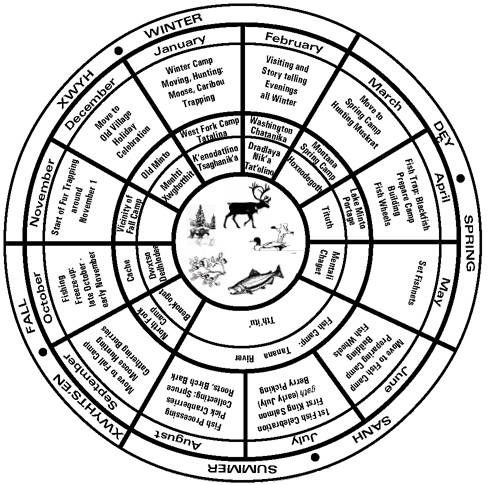
|
" They were wise about
where to go. They had an elder in the camp that told them
which way they should go. They never went just any old
place. They know where to go. They know a lot of things that
nowadays parents don't know. They use an Elder for the
leader. Every time they get stuck they go to the Elder. That
Elder he think and then he tell them, he know. All the
decisions, the old people used to make the decisions. They
got no books and no stuff to follow so they gotta follow the
people that have experience.
- Geraldine Charlie" |
Reading
|
|
" Well we talked
already about fall, winter, and spring. Already we
talked about that. And summertime. That's four
corners of life, right there. I think it's
important that the kids understand. They had
certain things they do in these four seasons, four
different in a year. And all these four seasons we
used to go out. We used to know the country. And
that's another important thing they used to teach
young people about, the country. Every season they
know where to move to get the kind of thing that
will be around at that season.
- Neal
Charlie" |
In Interior Alaska, the climate is demanding. Yet people
have lived here for thousands of years. They survived
because of skills and knowledge acquired through experience
and passed down through the generations. This body of
traditional knowledge is the common heritage of today's
Native people and its bearers are contemporary Elders.
When we asked Minto Elders what they know about snow, the
question didn't seem to make much sense to them. It was too
specific, out of context, and they were rightly reluctant to
begin talking about snow types and snow terminology without
first providing a context within which their very specific
knowledge about snow would make sense. They talked first
about their lives, their experience on the land, and the
lessons they learned from their parents. They talked about
the mobile lifestyle of their youth and emphasized its
seasonal patterns. They talked about their parents'
knowledge of the land, their knowledge of animal behavior.
Native knowledge is based upon long experience of living
off the land and is best understood in that context.
Alaska's Native people possess in their cultural heritage a
great deal of specific knowledge about all kinds of natural
phenomena, including snow and the winter environment. But
before we move on to investigating specific snow types, we
need to understand how they came to know what they know.
The following comments from Minto Elders are a sample
drawn from several hours of conversation, and are intended
to give just a sense of the pattern of traditional
activities. In this brief sketch, we will not get into all
of the interesting and important topics addressed by the
Minto Elders, such as animal behavior, weather observations,
place names, and social history and customs. These topics
will come up in the accompanying Activity called
"Documenting Seasonal Activities." Students
are encouraged to listen for this information and document
their findings. Teachers are encouraged to look for
connections with other topics they teach and to bring Elders
and local experts into their classrooms on an ongoing basis.
|

photo by Wallace M. Olson from Handbook of North American Indians,
Smithsonian Institute, 1981
Sharing of the first salmon, Old Minto, 1967
|
Seasonal
Mobility
"In the spring time they
used to move to where they call spring camp. Mostly where
they think the ducks come early. And our time when we were
raising our kids, we used to call it spring camp where we
hunt muskrat. Because we eat the bodies and we sell the
skin, too. So that was very important to us in the
springtime, to stay in the spring camp to get muskrats and
stuff. Summer time they go down to the Tanana river for
fishing, on the Tanana River.
And the fall time we stay where there's moose. Good moose
hunting time. That's the time we try to put away as much
meat as we can for the winter. We know just where to move to
get meat for the winter. So that was four different kind of
seasons that we used to look forward to. We know where we're
gonna move. They start planning [for winter] right
after they get through fishing on the river down there. They
start planning it. Maybe it could be last part of August,
somewhere around there. Anyway they were ready all the time,
for the four seasons.
First of November they started to trap for fur. Remember
I tell you they used to use fur for clothes, so they add
that trapping to what they're doing for fall camp. Camp
there until Christmas. And then after Christmas they move
out to winter camp. After Christmas, after New Year. After
they celebrate New Year and Christmas in the village, in the
Old Village down there. I'm talking about Old Minto. Were
talking about something they don't do no more. We're talking
about something we used to do. After they celebrate, that is
when they move to what they call winter camp.
We caught the end of it, us. But our people, our grandma
and them they used to do a lot of that. Moving around, yeah.
I mean we had a new camp every day and you do a lot of
walking. Sometimes two or three days and they move again.
Just to keep it going. If they stop too long in one place
they probably get hungry. You know, they didn't have no
store. They stay there two or three days. And hunter he
catch moose way up, way up Tatalina [River] or way
up Washington [Creek]. And they move camp up closer
to where he catch the moose, so they don't have to haul it
that far. They're moving up that way anyway.
The whole camp moved together. When the chief said we're
going to move tomorrow, everybody gotta move. Everybody
gotta have snowshoes. Or they make a trail so that people
who don't have snow shoes can walk, you know. The hunter
gets the moose and comes back and you go on their trail.
Cause when you walk on snowshoes, overnight the trail gets
hard.
- Neal Charlie" |
Note:
The Minto Elders sharing their stories here grew up in the 1920s and
30s prior to the establishment of schools and modern villages. They
grew up speaking their native language and participated in a highly
mobile lifestyle following patterns handed down by their ancestors.
Though things have changed a lot during the lifetime of today's
Elders, many current subsistence practices are based on traditional
knowledge and practices. During the year, think about how current
subsistence practices are connected to those traditions.
Discussion
- Describe the main activities of each season for the Minto
area.
- Imagine living the lifestyle described above. What parts would
you find
difficult? What would you enjoy?
- What kind of environment did Minto people seek out during each
season.
- What was the basis of leadership in their society?
|
Fall
"Well we move to fall camp
from Old Village. We used to move over here [near
Minto] to what they call fall camp. That means they're
gonna stay here and spend freeze-up here. It used to be
right there at what they call North Fork. Or they move out
to what they call Cache, Dwxtso Dedhdlode. It means
you put your cache away there. This is the meaning of fall
camp, they move to special place. We used to move all the
way from Old Village to here to the place called
Benok'oget, right there, right corner of this hill,
point of this hill here (near Minto). You can just go to the
bank and fish with fish hook there. That's one of the
reasons they do that. And before fall freeze they set
fishnet there, catch fall fish. And they pick berries from
there. And they hunt moose, and catch bear. And chickens
[ptarmigan] and rabbits, whatever they can catch, to
get ready for winter. And that's the reason it was a good
place. And the same thing with the other place Cache,
Dwxtso Dedhdlode. They used to put in fish traps, and
good place for hunt moose, hunt ducks in the fall. So they
pick two place to move for fall. Not everybody move there,
maybe two or three families maybe. Same thing over there,
maybe two or three families.
- Neal Charlie
They hunt for moose for the skin because we need the
skin. In the fall they hunt moose and sheep. Moose meat.
They go out try to get 'em. Sometimes they stay out for two
weeks before they can get a moose. They have to paddle, too,
up the Nenana river. [Wilson Titus lived near Nenana as
a boy.] That's pretty swift current up there, you know.
You stop there and hunt back in the woods. Look around, look
for fresh moose track. They get a moose way up the river
someplace. They can come down in about two, three hours.
When they go up for two or three days. That's fast water
coming down.
I remember one time my dad and my two brothers went out.
A couple of times they did that. They go up there, right
above the fish camp there, there's a slough there coming
out. You go up that slough, way up there. There's a long
lake there, and they leave the canoes there. There's little
hill on this side, all the way up. They walk all the way up
and they hit that Nenana River way up there. One time my Dad
he caught two moose up there. He's figuring what he's gonna
do. So he take little nails, you know, little nails they
build canoes. He take the moose skins, cut the hair off and
made that canoe and come down by the river. Pretty hard to
come down, but they can paddle it you know, the whole load.
Made from moose skin with a frame. You could use willow
on that. It's a pretty good canoe. You're not worried about
tearing it, anything. You hit a rock, it's shallow, you just
slip right on.
- Wilson Titus" |
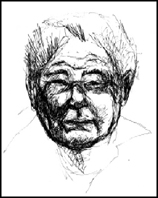
Chief Peter John of
sketch by Claire Fejes from Villagers,1981
Discussion
- Describe the fall subsistence activities of Minto Elders.
- Describe the fall moose hunting strategy.
|
Winter
"You got xwyhts'en
[fall], you got xwyh, that's winter. We figure it
starts around November, it starts around November,
wintertime. - Neal Charlie
Usually winter start right now. Benenh Taxuk'oddhi
is November. The beginning of winter. Benenh
Taxuk'oddhi means it freeze up, everywhere it freeze up
in November. In November they stay one place for all fall,
from beginning of moose rutting until after this [late
November]. They go to village like and stay there
getting ready until Christmas. And then after Christmas they
move. After that they move in January, move to different
camp. Move way up Washington sometime, up Tatalina
sometimes. Whichever way they're planning on going. -
Evelyn Alexander
You wait until after New Year's. Then people, they move
out just like my dad used to do. They move way up the
Tatalina, Washington, Chatanika. Look for moose meat. They
used to look for moose skins, you know. Cause they don't
throw away skin, they tan it. They tan it or either make
babiche (rawhide webbing). Babiche you gotta use for sleds
or use for snowshoes. They use the light stuff for snow
shoes. - Wilson Titus
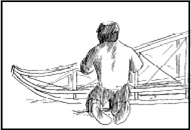 You
know Wickersham Dome? There's another creek all the way down
to the Beaver Creek. They move down that way mostly, you
know, for caribou. Sometimes there used to be a lot of
caribou on that Wickersham Dome, stay there all winter, you
know. Mostly caribou because long time ago there was hardly
any moose, moose was scarce. I was hunting by the time moose
was scarce. There was hardly any moose, compared to right
now. That's why I tell them young boys, it was like them
days right now you'd never get any moose. It takes good
hunters to get a moose. They track them down in the woods,
back in the woods there. Mostly they move out look for
caribou, wherever caribou was, all winter, you know. -
Wilson Titus You
know Wickersham Dome? There's another creek all the way down
to the Beaver Creek. They move down that way mostly, you
know, for caribou. Sometimes there used to be a lot of
caribou on that Wickersham Dome, stay there all winter, you
know. Mostly caribou because long time ago there was hardly
any moose, moose was scarce. I was hunting by the time moose
was scarce. There was hardly any moose, compared to right
now. That's why I tell them young boys, it was like them
days right now you'd never get any moose. It takes good
hunters to get a moose. They track them down in the woods,
back in the woods there. Mostly they move out look for
caribou, wherever caribou was, all winter, you know. -
Wilson Titus
You see right now, November, there's hardly any snow. We
don't know if we'll have snow, but it can get a lot of snow
in January and February. So that's when people start moving
out, traveling. Somebody had to go out and make the trails.
They walk, they cut trails. There's four or five of them
maybe. They snowshoe and they make trail. Leave it like that
for about two or three days, to drive dogs on. Then we move
to another different camp. If you make a trail once you use
it all the time, all winter. We go back and forth on there.
If we move out we make trail, we come back on that trail.
Like we break trail over to Sawtooth [Mountain],
we'll move back on the same trail. It'll be a good trail by
that time.
- Evelyn Alexander" |
Discussion
- What natural events signal the beginning of winter?
- When did people gather? When did they disperse?
|
Cultural Standard:
Curriculum
D1
draws parallels |
|
Winter
Trails
"Xwyh tena
is winter trail. Gee we used to work hard. Yeah,
can't keep still, all day long. After they break
trail they hunt, too. I remember we move up
Tat'ali No' [Washington Creek] and
we stopped for lunch, gonna make tea. They don't
know where to put up camp.  They
say we wouldn't go far after we drink tea, cause we
gotta look for camp. As we were drinking tea moose
crossed the trail. Fresh moose tracks. With the axe
handle they poke it a little. When it's soft that
means not long ago. When it's kind of hard it means
this morning or last night. This old man he went
after it. We heard two shots. That's all. We were
drinking tea and here comes that old man. He shot
two moose. We didn't go far we just went from here
to about Lodge [Minto Lodge - about 100
yards]. We were forced to put up camp there.
And some boys went over with that old man to
butcher that moose. And some people helped that old
lady to put up tent. They set their stove and wood
and build fire and melt snow. They cooked the
stomach part. When everybody get through putting up
tent, everybody eat with that old lady. The one
that her husband catch moose. They
say we wouldn't go far after we drink tea, cause we
gotta look for camp. As we were drinking tea moose
crossed the trail. Fresh moose tracks. With the axe
handle they poke it a little. When it's soft that
means not long ago. When it's kind of hard it means
this morning or last night. This old man he went
after it. We heard two shots. That's all. We were
drinking tea and here comes that old man. He shot
two moose. We didn't go far we just went from here
to about Lodge [Minto Lodge - about 100
yards]. We were forced to put up camp there.
And some boys went over with that old man to
butcher that moose. And some people helped that old
lady to put up tent. They set their stove and wood
and build fire and melt snow. They cooked the
stomach part. When everybody get through putting up
tent, everybody eat with that old lady. The one
that her husband catch moose.
- Evelyn Alexander
[How did you make trails?] Double track.
You gotta walk on snowshoes, one on this side, one
on this side to make trail wide enough. A snowshoe
and a half. Or you could make it wider you know if
you got a bunch of people. Wide trail. Make a wide
trail so it [your sled] don't turn off you
know, deep snow. When you got load and you get off
in that soft snow you gotta get out in front and
pull it back.
[Can you drive on the trail right after you
make it?] Yeah, you could do that, dogs follow
you behind, you know. But they usually break
through like one day ahead, or maybe a couple of
days. See when they got camp they go out on
snowshoes. Where they hunt they got trail, maybe a
whole bunch of them. And they got pretty good
trail, hard trail then. And when they gonna move
they move right on the snowshoe trail you know.
- Wilson
Titus" |
|
Discussion
- When does deep snow usually occur in your area? What did this
mean for mobile people?
- What does "break trail" mean? What happens to the snow when
you break trail?
- How can you tell the age of an animal track? Why is this
important?
|
Spring
"March is what we call
spring camp. March is the beginning of spring, early in
March. We start getting ready for spring camp. From winter
camp we move to spring camp. We move to spring camp in
March. In March at spring camp we move there to catch
muskrat and to try to catch fish and black fish. [How do
you say spring?] D5y.
 Well,
like before in winter time we figure out where, where would
be the best place. Again we ask the elders where we should
go. They used to call Montana [Creek] spring camp up
this way, Montana spring camp. And out where they call Lake
Minto. It was the two main places where they used to move,
because there's more lakes in those two areas. There's good
places to trap muskrat. That was the reason they picked
these two places. Montana spring camp and Lake Minto spring
camp they use to call it. Oh yeah, Birch Hill too, where
they used to call Birch Hill spring camp. Well,
like before in winter time we figure out where, where would
be the best place. Again we ask the elders where we should
go. They used to call Montana [Creek] spring camp up
this way, Montana spring camp. And out where they call Lake
Minto. It was the two main places where they used to move,
because there's more lakes in those two areas. There's good
places to trap muskrat. That was the reason they picked
these two places. Montana spring camp and Lake Minto spring
camp they use to call it. Oh yeah, Birch Hill too, where
they used to call Birch Hill spring camp.
They start hunting ducks in April for food. And then they
start to catch pike with dipnets. That's some of the reasons
we pick that place over at Old Minto, cause you could do
that, fish through the ice with dipnet. After water start
coming, and they could use dipnet, at that time of year the
snow is melting. Melting, every day, and the water opens up.
There's water all over.
We got muskrat March, April and May. Around the 20th of
May is when they stop shooting muskrats. They mate at that
time, gonna have babies pretty soon. They just disappear.
They don't shoot them when their gonna have babies. Just
like moose, they let them have babies. You hunt muskrat you
can catch maybe 10-12 one night and the next night you're
not gonna catch nothing. They just disappear. So that's the
end of spring, end of ratting time. That's the beginning of
summer. No more ice, no more snow.
- Neal Charlie" |
 Discussion Discussion
- Where did the Minto Elders go in spring?
- What is "ratting"?
- What natural events signal the end of spring?

|
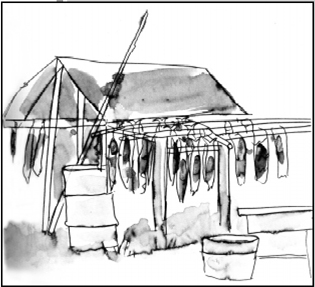
sketch by
Claire Fejes
from
Villagers, 1981
|
Summer
"We mostly looked forward
to going to fish camp, get ready for fish wheel. We start
building fish wheel around June, hey? Start catching fish in
July. Start fishing for a little while, getting ready for
fishing. Getting poles to hang up fish. When you're gonna
build fish wheel you gotta look for small spruce poles.
Sometimes we have to do all our work over again because
flood. Fishwheel. All the time we're just busy every day.
Most of that time we have hardly anything to eat while we
getting ready for fish, but we always manage. By the time we
start going out to get fresh berries. First of July we start
catching our first fish. End of July is when we start
picking berries.
- Geraldine Charlie
You ever see fish wheel? The basket is the one that catch
the fish. They do that at Culture Camp [at Old
Minto], get that ready. And we start it as soon as we
get ready around first of July to fourth of July and we have
a big potlatch with that. We don't stick it in the freezer,
we share it. We stay in that fish camp until maybe the first
of September. We stay in that fish camp through July and
through August, dry that fish, take care of the fish we
catch. By the time that we get through doing that it's time
for moose hunting season. Moose hunting time. And that's
what we call fall time, hunting ducks and moose. During that
period of fishing and stuff they try to get berries,
blueberries and blackberries. And the cranberries and stuff
is ready by August.
When you make snowshoes you gotta make it out of birch
tree, because birch tree is the strongest kind of tree there
is. And the same thing with sled, sled runners. In summer
time birch is easier to get and easier to bend. They claim
that if you get birch in summer it's stronger. And it's easy
to cut, easy to plane. Another thing we used to do is we
used to get birch bark as much as we can get, and spruce
roots. We start to get this stuff while it's fishing time.
You stay in fish camp the whole summer, you'll find out
that's one of the busiest times right there.
- Neal Charlie" |
Discussion
- Why are people so busy in summer?
- What summer activities contribute to a successful winter?
Refer to the chart
on page 13, "A Seasonal Round."
- Why is it "round"? Would another shape be better? Consider
making a round
for your community after completing the following activity.
|
Activity: Documenting Seasonal
Activities
Ask local Elders to teach you about traditional
life and activities.
Time: 2-3 hours
Material:
Voice recorder and cassette tape,
Snow Journal, page 9
Map
- Work in small groups. Perhaps 2-4
students with each Elder is ideal. Find a quiet location
where Elders and students are comfortable.
- Use a tape recorder if the Elders
and students are comfortable with this. It is better to
listen attentively during the discussion and to take
notes later.
- Ask Elders to talk about the seasons
and the things they did in each season. Ask especially
about winter. Start with general questions like "How did
people live in the winter? What did they do? Where did
they go?" Listen for subsistence activities, observations
about nature, and important places.
- Don't interrupt with too many
questions. You don't want to ruin the story.
When the Elder finishes talking about a topic, they will
pause and then you may ask questions.
- If possible, record the names of the seasons
and months. This is a difficult one, though.
People may not remember, and you'll need help from your
Bilingual Program Teacher or other adult literate in the
local language to transcribe the names.
- After meeting with the Elders, record your
observations in the Snow Journal. Go back to the
Elders to check the accuracy of your notes. Then answer
the Discussion Questions in the Snow Journal.
|
Cultural Standard:
Schools
A2
provides opportunities to document Elder's cultural
knowledge |
|
Cultural Standard:
Students
E2
understand the ecology and geography of the bioregions they
inhabit |
|

Snow Journal
pg. 8
|
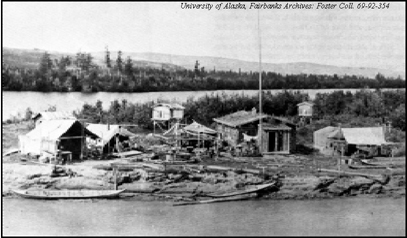
Tolavana fishing camp and site of trading post, post office,
and telegraph station established in 1903.
Photographed July 1919.
Notes:
Observing Snow
Introduction
The Four Corners of Life
Water: the Stuff that Makes Snowflakes
Snow on the Ground Changes Through Time
Exploring Native Snow Terms
Glacier Investigations
Open Note Review
Conclusion
Bibliography & Resources
|
 The
University of Alaska Fairbanks is an Affirmative
Action/Equal Opportunity employer, educational
institution, and provider is a part of the University of Alaska
system. Learn more about UA's notice of nondiscrimination. The
University of Alaska Fairbanks is an Affirmative
Action/Equal Opportunity employer, educational
institution, and provider is a part of the University of Alaska
system. Learn more about UA's notice of nondiscrimination.
Alaska Native Knowledge
Network
University of Alaska Fairbanks
PO Box 756730
Fairbanks AK 99775-6730
Phone (907) 474.1902
Fax (907) 474.1957 |
Questions or comments?
Contact ANKN |
|
Last
modified
August 17, 2006
|
|
|